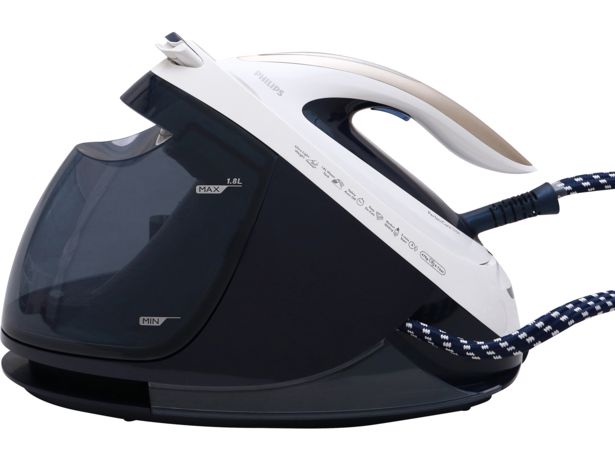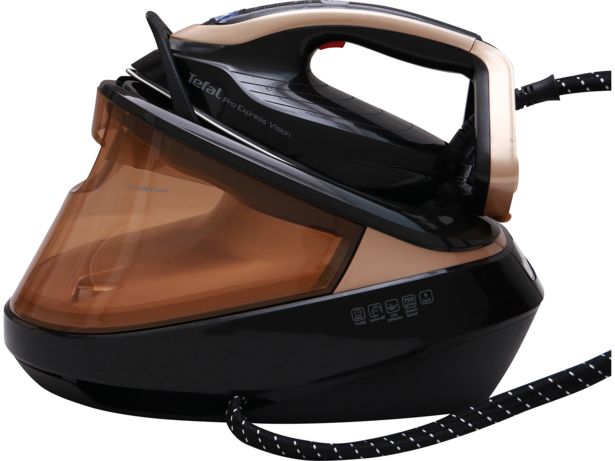How to clean an iron

Knowing how to clean an iron is essential. Irons that are clogged up with limescale or have sticky residue on the bottom can make ironing harder work, and even damage your clothes.
While most of us don’t descale our iron as often as we should, when limescale builds up it can make your iron less steamy. This mean it will take even longer to get through your laundry pile.
Be inspired to make home improvements. Sign up for our Home newsletter – it's free monthly
How to clean the bottom of an iron
If you have sticky gunk or residue on the base of your iron (the soleplate), cleaning it off will help your iron glide more smoothly and avoid damaging or staining your clothes.

To clean the bottom of an iron:
- Put the iron on the lowest heat setting
- Gently wipe a soft, damp cloth over it to remove any stickiness
- Use a damp cotton bud to clean in and around the steam vents
- Let it dry thoroughly before using it to iron.
Always check the user manual before cleaning, as soleplates are made with different materials and some models come with specific recommendations.
Make sure you use a soft cloth, rather than a harsh or abrasive cleaning pad, and wipe gently to avoid scratching it. Scratched soleplates can catch and damage fabrics.
It's also worth bearing in mind that no matter how careful you are, some soleplates are far more likely to pick up scratches than others. That's why we put each iron through our tough scratch tests.
Only those that shine in our tests make it onto our list of the best steam irons.
Removing melted or burnt fabric from an iron
Burnt or melted fabric fibres can be difficult to remove from an iron. But if you leave it on the soleplate, it may damage or stain your clothes. Unless your user manual recommends otherwise, follow our three steps below.

To remove burnt fabric from the bottom of your iron:
- Turn the iron to a medium heat setting
- Dampen a cotton cloth or towel
- Pass the iron over the damp material for a few minutes to draw the fibre off the soleplate.
Iron cleaning hacks tested
The web is full of iron cleaning hacks – toothpaste, ice, newspaper, nail varnish remover, lemon juice. Frustratingly, most of them don't work, but we've found one everyday product that does actually work to clean your iron's dirty soleplate, and you won't believe what it is.
Watch the video to find out...
How to descale an iron
Most irons come with a built-in cleaning system to descale an iron. The type of cleaning system varies between models:
- Some irons use pressurised steam to blast limescale out through the vents
- Some connect to your tap to flush out the system
- Others collect limescale in a ‘chamber’ or ‘collector’ that can be easily removed and emptied.
When limescale builds up inside your iron, it can clog up the steam vents and drastically lower steam levels. So you'll have to put in more effort to get rid of creases.
Irons that are full of limescale can also deposit it onto your clothes, leaving white or brown chalky marks behind.
When we asked 5,490 people what causes problems in their steam irons*, limescale was amongst the top three most common problems. So it's worth finding an iron with an effective descaling system.
We reveal which steam iron brands you can trust and which are more likely to have problems.
(*Online survey by Which? conducted in May 2022)
Which irons are easiest to descale?
New models often have shiny new descaling systems, but some systems are far fiddlier and more time consuming to use than others.
While some ‘self clean’ in less than two minutes, the worst demand you hold the iron over the sink for 15 minutes or even soak parts in lemon juice for four hours.
Our tests have revealed the more demanding descaling systems aren’t always the most effective at limiting the effects of limescale.
We’ve found some really simple-to-use descaling systems do a perfect job of getting steam power back to its original level. We’ve also found some with really complicated systems that actually clog up the system more.
In general, more expensive irons tend to be easier to descale, and their cleaning systems are more effective at restoring steam levels. Steam generators also tend to have cleaning systems that are more effective and easier to operate. But we’ve also found some brilliant budget steam irons that score highly for both.
How often do I need to descale my iron?

Manufacturers generally recommend descaling between every one to three months. However, others ask you to do this as frequently as every two weeks. In reality, we know most people don’t descale their iron as often as this.
Our tests have found that some irons are better at coping with limescale than others. With one of our best steam irons you might be able to get away with descaling less regularly. But with others you’ll notice steam levels dropping off drastically after a few months’ use and will need to clean it regularly to keep it performing at its best.
If you can, it’s always best to follow manufacturer’s guidelines if you want to keep your iron within its warranty – so check the manual before you buy if you want an iron that doesn’t require regular cleaning.
To keep your clothes looking as fresh as possible, it's important to keep your other laundry appliances in tip-top condition too. Take a look at our tumble dryer tips and maintenance to find out how.
Mandatory iron cleaning systems
Some irons have mandatory cleaning systems – the iron will stop producing steam until it’s been cleaned.
This can be a handy nudge for the procrastinators among us, but it could also be a pain if you’re hurrying to get a shirt ready in the morning.
Our tests found that mandatory cleaning systems are not always that effective at keeping limescale at bay, so it’s worth checking our steam iron reviews before you buy.
Choosing the best steam iron
For more advice on what to look for, watch our video on how to buy the best steam iron.
If you’re happy to spend a bit more and are looking for something a bit more powerful, a steam generator iron will do a fantastic job.
Be inspired to make home improvements. Sign up for our Home newsletter – it's free monthly


